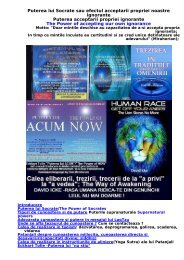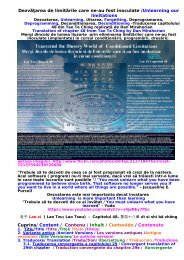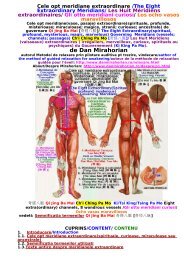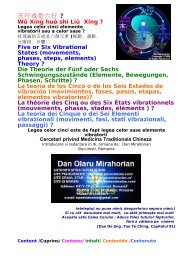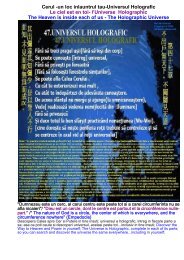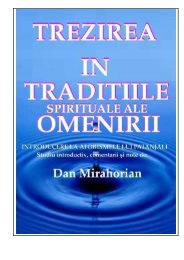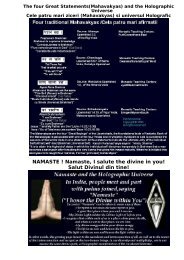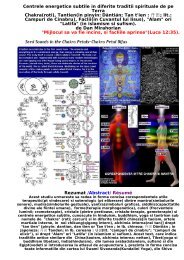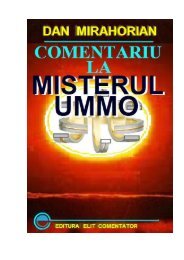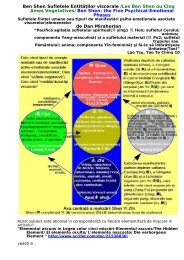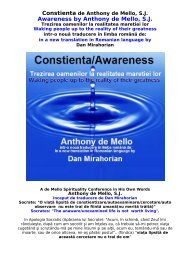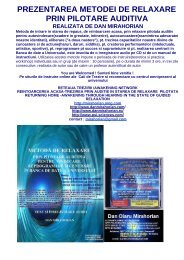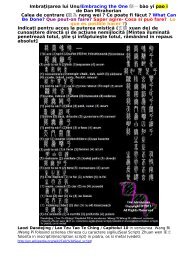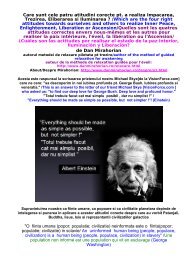Udana Vayu: localizare :gat si cap; centru ... - Dan Mirahorian
Udana Vayu: localizare :gat si cap; centru ... - Dan Mirahorian
Udana Vayu: localizare :gat si cap; centru ... - Dan Mirahorian
You also want an ePaper? Increase the reach of your titles
YUMPU automatically turns print PDFs into web optimized ePapers that Google loves.
Inima este pricipalul <strong>centru</strong> al corpului energetic (pranamaya kosha).<br />
Capul este pricipalul <strong>centru</strong> al corpului senzorial(manomaya kosha).<br />
Prana<br />
Prana as a general term refers to the life force that flows through all things. “The senses of<br />
perception and the organs of action are all able to function because of prana. Just as the<br />
spokes of a chariot wheel are fixed to the hub, so the body, the senses, the mind, and the<br />
intellect all depend on prana. The prana separates into different aspects, which fulfill different<br />
functions in the body, so that the body may work in an orderly manner. To carry out its various<br />
tasks, this prana pervades the individual body in five forms: prana, apana, samana, vyana,<br />
and udana. But it is still all one prana.<br />
Of the five primary pranas in the body, two pranas – prana vayu and apana vayu – are<br />
regarded as most important. A ‘vayu’ is a ‘wind’ or force, and these two forces or energies are<br />
opposed yet complementary. We practice the bandhas in order to bring these two energies<br />
into balance, both to enhance the health and functioning of the body, and to bring the mind<br />
into a state of stillness.<br />
The exhalation is moved by an energy known as apana. The apana vayu is a force for<br />
expelling from the body, usually taking the form of a downward contracting movement. Its<br />
home is the pelvic floor, so the impulse to exhale originates from a point at the center of the<br />
pelvic floor.<br />
The inhalation is moved by the energy of prana vayu in the oppo<strong>si</strong>te direction.<br />
Although the inhalation draws the breath down into the body, the energy of the inhalation is at<br />
the same time experienced as ri<strong>si</strong>ng within and spreading like the opening of a lotus flower.<br />
The home of prana is in the heart at the center of the chest, where the blossoming quality of<br />
the prana is most felt; the prana rises from<br />
the pelvic floor toward the heart in yogic breathing.<br />
Prana(energia vitala) nu exista doar in plan manifestat, la nivel gro<strong>si</strong>er (fizic; material) <strong>si</strong> subtil<br />
( energetic <strong>si</strong> informational), ci <strong>si</strong> in plan nemanifestat. Chiar Purusha ori Sinele suprem poate<br />
fi con<strong>si</strong>derat ca fiind Prana nemanifesta, fiindca este o forma a energiei constiintei (Devatma<br />
Shakti ori Chiti Shakti). Din Prana nemanifesta a Purei Constiente vine Prana manifestata a<br />
creatiei, prin care intregul univers intra in fiintare. Even Kundalini Shakti, the serpent power or<br />
inner power that transforms consciousness, develops from the awakened Prana. On a cosmic<br />
level there are two ba<strong>si</strong>c aspects of Prana. The first is the unmanifest aspect of Prana, which is<br />
the energy of Pure Consciousness that transcends all creation. The second or manifest Prana is<br />
the force of creation itself.<br />
Relative to our phy<strong>si</strong>cal existence, Prana or vital energy is a modification of the air element,<br />
primarily the oxygen we breathe that allows us to live. Yet as air originates in ether or space,<br />
Prana arises in space and remains closely connected to it. Wherever we create space there<br />
energy or Prana must arise automatically. Prana has many levels of meaning from the breath<br />
to the energy of consciousness itself. Prana is not only the ba<strong>si</strong>c life-force, it is the master form<br />
of all energy working on the level of mind, life and body. Indeed the entire universe is a<br />
manifestation of Prana, which is the original creative power.<br />
Prana arises from the quality (guna) of rajas, the active force of Nature (Prakriti). Nature<br />
herself con<strong>si</strong>sts of three gunas: sattva or harmony, which gives rise to the mind, rajas or<br />
movement, which gives rise to the prana, and tamas or inertia that gives rise to the body.<br />
Indeed it could be argued that Prakriti or Nature is primarily Prana or rajas. Nature is an active<br />
energy or Shakti. According to the pull or attraction of the higher Self or pure consciousness<br />
(Purusha) this energy becomes sattvic. By the inertia of ignorance this energy becomes<br />
tama<strong>si</strong>c. A strong vital or Pranamaya kosha, however, is important for the spiritual path as<br />
well, but this is very different than the egoistic or de<strong>si</strong>re oriented vital. It derives its<br />
strength not from our personal power but from surrender to the Divine and its great<br />
energy. Without a strong spiritual vital we lack the power to do our practices and not fall



